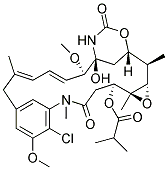Ansamitocin p-3 (Maytansinol isobutyrate, NSC292222) (Synonyms: Antibiotic C 15003P3) |
| Catalog No.GC25075 |
Ansamitocin p-3 (Maytansinol isobutyrate, NSC292222, Antibiotic C 15003P3) is a potent inhibitor of tubulin polymerization with IC50 of 3.4 μM.
Products are for research use only. Not for human use. We do not sell to patients.

Cas No.: 66584-72-3
Sample solution is provided at 25 µL, 10mM.
Ansamitocin p-3 (Maytansinol isobutyrate, NSC292222, Antibiotic C 15003P3) is a potent inhibitor of tubulin polymerization with IC50 of 3.4 μM.
Ansamitocin p-3 at 5 μM completely inhibits the polymerization of tubulin isolated from bovine brains, but in contrast to VCR, Ansamitocin p-3 at a high concentration of 80 μM does not leads to the aggregation of tubulin. Ansamitocin p-3 at 16 μM also potently depolymerizes the polymerized tubulin (IC50 = 3.8 μM). The addition of Ansamitocin p-3 to culture cells blocks the morphological alteration of AC cells from fibroepithelioid to a glial cell type caused by the exposure to a certain concentration of dibutyryl cyclic adenosine 3':5'-monophosphate. In addition, Ansamitocin p-3 treatment at 16 nM causes the well-defined network of cytoplasmic microtubules of A31 cells rapidly dispersed. Short-term Ansamitocin p-3 treatment also inhibits the synthesis of DNA in A31 cells or KB cells. These results confirm that Ansamitocin p-3 acts by interfering with the microtubule assembly system, thus resulting in an inhibition of mitotic spindle fiber formation and, ultimately, cytokilling. [1] Ansamitocin p-3 displays potent cytotoxicity against A-549, HT-29, and MCF-7 cells in a dose-dependent manner with ED50 of 4 ×10-7, 4 × 10-7, and 2 × 10-6 μg/mL, respectively. [2] Ansamitocin p-3 also exhibits cytotoxicity against HCT-116 cells with a much low EC50 of 0.081 nM. [3] Ansamitocin p-3 enhances the effect of radiation both in Drosophila cells and human cancer cells in a p53 dependent manner. [4]
Ansamitocin p-3 treatment (>1 μg) significantly suppresses the growth of leukemia SN36, and induces an increased arrest in metaphase of P388 leukemia cells. Ansamitocin p-3 treatment at 25 μg/kg/day significantly prolongs the survival time of mice bearing i.p. B16 melanoma by 130%. Ansamitocin p-3 treatment also significantly prolongs the survival time of mice bearing Ehrlich ascites carcinoma, Sarcoma 180, and P815 mastocytoma, while slightly prolongs the survival time of mice bearing ascites MOPC-104E myeloma,leukemia L1210, and leukemia C1498. [1]
[1] Ootsu K, et al. Cancer Res, 1980, 40(5), 1707-1717. [2] Suwanborirux K, et al. Experientia, 1990, 46(1), 117-120. [3] Young DH, et al. J Biomol Screen, 2006, 11(1), 82-89.
Average Rating: 5 (Based on Reviews and 30 reference(s) in Google Scholar.)
GLPBIO products are for RESEARCH USE ONLY. Please make sure your review or question is research based.
Required fields are marked with *




















